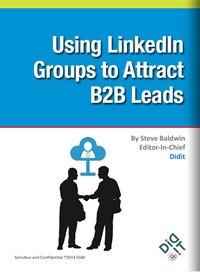August 7, 2014: We’ve written before about the business advantages of using LinkedIn, and hope you’ve downloaded our free e-book, The Ultimate Guide to Marketing on LinkedIn. Today we want to talk about LinkedIn Groups, because they provide businesses with an opportunity to participate and engage with members of this powerful social network in a way that bypasses some of the service’s ordinary restrictions against contacting someone you don’t know well. For this reason alone businesses seeking to make an impact on the service should be using Groups.
But Groups provide many other benefits as well. Groups let business leaders distinguish themselves by sharing intelligence, answering questions from peers, posting relevant links, and commenting on important industry discussions.
Groups let businesses:
1. Show thought leadership by sharing content and commenting on topical posts in the group.
By ÁWá (Own work) [GFDL (http://www.gnu.org/copyleft/fdl.html) or CC-BY-SA-3.0 (http://creativecommons.org/licenses/by-sa/3.0/)], via Wikimedia Commons
2. Connect with peers in a way that may be instrumental to a business conversation.
By Someone’s Moving Castle (Template:Revathi) [CC-BY-SA-3.0 (http://creativecommons.org/licenses/by-sa/3.0)], via Wikimedia Commons
3. Develop insights into the pressing issues in your industry by participating in relevant conversations.
By User:Multichill (Own work) [CC-BY-SA-3.0 (http://creativecommons.org/licenses/by-sa/3.0)], via Wikimedia Commons
What to look for in a LinkedIn Group
Your ideal target set consists of LinkedIn Groups that are relevant to your industry, have a healthy stream of conversational streams happening, whose members consist of people likely to include either prospective customers or others who have an influence on such people. There are likely to be a number of groups — perhaps even a very large number — active in your business vertical, and at first blush these groups might look very similar. In operation, however, they may work very differently, and the actual business value they deliver to you may vary widely.
For example, some groups may have very loose moderation policies, while others may be tightly policed by the moderator(s). Others may be dominated by one or two voices, whereas others may have broader-based participation from their members. Until you actually join a group and spend time in the conversational trenches, it’s impossible to definitively determine whether your experience will be rewarding or frustrating. But you can save a lot of such trial and error by doing advance due diligence using LinkedIn’s tools for identifying suitable groups for you.
In a forthcoming article and free e-book, we’ll take you this process in a step-by-step manner.
Have a question about Social Media? Contact us.
- 10 Mistakes to Avoid When Using QR Codes for Marketing - September 20, 2023
- Kevin Lee on How AI Changes the SEO Landscape - August 31, 2023
- The Power of Compound Marketing: Kevin Lee Presents @ 1MediaWorld 2023 Global Conference - March 7, 2023

